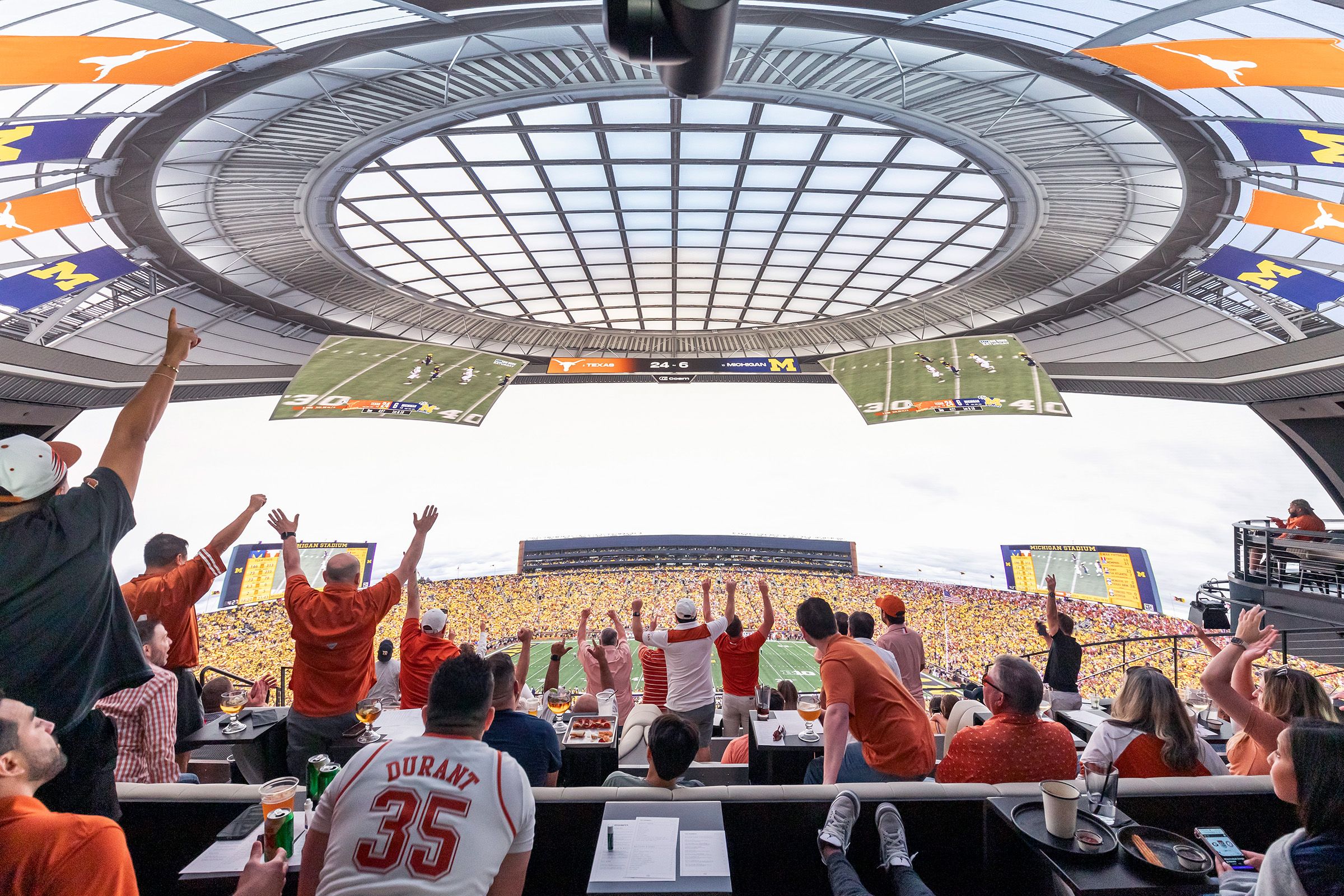An early February 2024 game between English Premier League contenders Liverpool and Arsenal was set to be a vital clash that would help determine the eventual league champion. Liverpool held a narrow lead in the league, but an Arsenal victory would draw them within just two points of overtaking their rivals in the standings.
I was lucky enough to be watching this vital match up close and decided to brag a bit: I texted a friend, a keen EPL fan, with a couple pictures of my pitch-side view. He was jealous, naturally, and also probably a bit confused at why a limited soccer fan like myself would be flying thousands of miles from my home in the western US all the way to the UK to watch a match between two clubs I have no connection to.
But it was a ruse!
I wasn’t across the pond, even if the pics I sent my buddy sure looked like it. I was just 20 minutes from my home in Salt Lake City at the Cosm Experience Center, a facility on the University of Utah campus with a 65-foot, 8K screen. The game didn’t just look real from pictures; it felt real for large chunks of the livestream, with the massive wraparound screen and thumping spatial audio system providing sights and sounds that truly made me feel like I was in the stadium.
My silly little trick isn’t remotely novel, whether at this smaller SLC venue or one of Cosm’s two larger locations in Los Angeles and Dallas, where the company showcases its “shared reality” immersive experiences. Cosm reps tell me people take photos of the screen all the time, searching for some way to adequately capture the feeling of being at one of the broadcasts. Like The Sphere, the wildly popular venue in Las Vegas, it’s a jolt to feel such realism from digital displays—and to experience the roar of the crowd and a communal experience that’s a far cry from simply watching the game at home.
Cosm offers multiple viewing angles for soccer games.
Courtesy of Cosm
Cosm represents a growing trend in live sports experiences. The company made headlines when tickets for game 1 of the Yankees-Dodgers matchup in the 2024 World Series at its LA facility sold out in just seven minutes. Now the company is pioneering first-of-their-kind broadcasts across other leagues, including the NBA, NHL, and UFC.
I recently went back to the SLC facility for another demo. What I saw was a window into an immersive future—in sports, entertainment, and education—which can be accessed through any screen, from a towering Cosm dome to the phone in your pocket.
Game On
Cosm’s history is fascinating, and it touches on the earliest days of immersive projection systems.
The company’s roots in immersive tech date back decades, when said tech was pioneered for planetariums. The Cosm brand was born in 2020 when a leader in planetarium projection technology partnered with major entities in computer graphics and virtual reality. The name Cosm is derived from the collision of the Colosseum and the Cosmos.
Cosm proved its abilities in the immersive space through streaming feeds for VR coverage of the 2022 Olympic Winter Games and the 2022 FIFA World Cup, then opened its first official venues with large screens in LA and Dallas in 2024.
Those venues hold around 1,400 people, according to Cosm; the SLC venue I visited is much smaller, but has a similar setup. A lobby with huge LED screens welcomes visitors; classic stadium concessions are readily available, including seat-side delivery; like a real arena, seating is split into multiple levels.
Once I got inside, in front of me was that massive 8K screen—other Cosm venues use screens with even higher resolutions, including up to 12K—that took up my entire field of view and then some, wrapping around the sides of the venue and up over my head. The picture quality was insane; Cosm tells me its venues are the first true “black domes” in the industry, a design which minimizes issues like cross-reflection (an effect where light bounces off a display’s surface in unpredictable ways, causing diminished clarity and brightness) and allows for incredibly rich visuals. When combined with the use of high-quality LED lights for the actual displays, the resulting visuals are breathtaking.
“The system contrast is 10 times that of what you can achieve with any projector,” Cosm chief operations officer Kirk Johnson tells me.
For sound, Cosm uses an array of speakers—16 speakers plus four subwoofers at the SLC facility; 38 speakers and 15 subwoofers at the LA and Dallas locations—affixed at various points directly behind the LED displays, which are permeable to allow sound through them. This allows Cosm to make noises and effects sound like they’re coming from any part of the room, even seemingly behind me.
During hockey games, Cosm’s camera angles can virtually put you right on the ice.
Courtesy of Cosm
On the sports side, both the NBA (Cosm’s first league partner) and NHL experiences are amazing. Cosm can put you courtside for NBA games, both at center court and on either baseline. The NHL program feels a touch more immersive than that, even, particularly a corner view that’s technically from outside the glass, but truly makes you feel like you’re standing on the rink itself.
UFC was another highlight. Cosm’s standard UFC viewing angle is a perch just above the octagon, as if you were sitting on a magic carpet hovering a few feet off the ground; it’s a far better view than I’ve ever seen on a UFC pay-per-view. “We had a few fights where there was blood on the lenses,” Cosm president and CEO Jeb Terry tells me.
There are other views for UFC events as well, including octagon-side. Between bouts, it pans back to a wide shot in the stands.
“I feel like I have a seat in the crowd,” says Alon Cohen, UFC senior VP of research and development, of what it’s like to watch a match at a Cosm venue. “It gives you a different experience than if you put on a set of VR glasses. It gives you a different experience than going to a Sphere where everything’s so big.”
The view for UFC matches hovers over the octagon.
Courtesy of Cosm
While the Sphere comparison is unavoidable at first, Cosm doesn’t really consider the concert venue a competitor. They do such different things, even if both are enabled by incredible visual technology. “We both believe in an amazing human experience powered by technology, something that will wow you,” Terry says.
The non-sports experiences I sat through were just as impressive, including beautiful views of a performance of Cirque du Soleil’s “O” stage show. Maybe most impressive, though, was Cosm’s suite of tools that straddle between the worlds of entertainment and education.
First, Cosm brought me inside a true-life rendering of the Sistine Chapel. An engineer floated around the chapel using nothing but an Xbox controller; it felt like I was inside a drone flying around the room.
Cosm then showed me a bird’s-eye rendering of the building we were sitting in and its surroundings; think Google Maps, but on steroids. From there, the view zoomed out as we were transported several hundred miles to the LA Cosm facility, with every inch of earth between the two locations mapped on the screen. We then zoomed out even further to see the entire country, then the entire world, the entire galaxy, and the entire known universe.
All of this is brought to life on Cosm’s giant screen using a software platform called Digistar. It was originally developed to power computer graphics projections for planetariums in the 1980s and has evolved into a fully modern digital animation platform. (The company that developed Digistar is one of the handful that merged in 2021 to form Cosm.)
The system engineers tell me the Digistar software accurately maps every piece of space debris over one meter in size, including billions of stars and data points. Cosm folks tell me kids love this exercise of flying around the universe; it left my head spinning a bit.
With many of Cosm’s main offerings, sports especially, it’s about more than just the graphics and the visual quality. It’s the communal experience. The Cosm folks tell me that if the crowd in an actual arena is doing the wave during one of the livestreamed games, fans inside the Cosm venue will join in as it reaches their section. When a UFC fight ends in a knockout, everyone jumps out of their seat like they would if they were actually there.
“You feel like you’re in this space with people where that’s the appropriate reaction,” Cohen says. “The reactions you [get in Cosm] are the reactions you get in the arena.”
The actual Cosm facilities, however, are just one piece of the company’s overall role in the immersive space. The company hopes to eventually get its flavor of content into other facilities and onto other platforms.
Cosm’s tech also powers planetariums around the world.
Courtesy of Frank G Abbott III/Cosm
Even as it has expanded into sports and other forms of entertainment, Cosm has maintained a strong foothold in planetariums and similar educational venues. Europe’s first ever LED dome, the Prague Planetarium, integrates Cosm’s CX System backend technology. The company has been involved with facilities like the Arizona Science Center, the MOSI Saunders Planetarium in Tampa Bay, Florida, and the Shanghai Astronomy Museum. Cosm’s tech powers over 700 planetariums around the world.
Among its most recent ventures was at the Fort Worth Museum of Science and History, where in December 2024 Cosm helped convert the Texas museum’s decommissioned Omni IMAX theater into a 360-degree immersive dome, complete with 12,000 LED panels. This dome hosts all sorts of content, from Cosm-produced films to various educational programs for all ages; that same zoom-out-to-the-entire-universe feature I saw at my demo is a regular part of programming, for instance.
“It doesn’t just function as a regular screen. It can sort of be anything and do anything,” says Nikki Diller, VP of collections, interpretations, and programs for the museum. “People say the sky is the limit. I say the known universe is the limit, because that’s part of what our planetarium software can do.”
Like many other entities using the tech, the Fort Worth Museum is still figuring out the best ways to bring it to new audiences. The museum and various other Cosm partners have tried a number of approaches, from live orchestra performances to trivia and karaoke.
Cosm has also positioned itself as a central hub in the growing immersive entertainment space, one that some refer to broadly as “180 video”—a bit of a misnomer, as many of Cosm’s programs take up much more than 180 degrees in the field of view. Because Cosm has already done all the backend formatting, the platform can serve as a clearing house for content outside the giant dome setting.
Cosm can easily port its experiences over to VR, for instance. It can also provide ready-made content for smartphone-based “immersive” experiences where users move their devices around to engage with a 3D space.
Fans take in an immersive basketball game at a Cosm venue.
Courtesy of Cosm
Many of the NBA’s courtside VR game experiences, which place viewers right at court level with viewpoints on both baselines and at the center-court scorer’s table, are produced by Cosm. On the combat side, the company is involved with VR and phone-based experiences efforts for both UFC and WWE alike.
New immersive Cosm facilities in Atlanta and Detroit are set to open in 2026, the latter of which will contain betting-focused elements, due to the legality of sports gambling in Michigan. Terry says the company hopes to announce several other venues in the near future. Those who have worked with Cosm tend to be extremely optimistic about the company’s potential.
“I am bullish on Cosm,” Cohen tells me, before comparing the company’s potential to another unique in-person experience, TopGolf; the driving-range chain has over 100 locations around the world. “That’s at least how many Cosms there ought to be. These things have a much smaller footprint, they fit in more places. Any major city that has a certain number of people should have a Cosm.”




